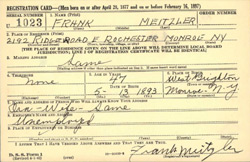
The following news release was received from Ancestry today. It covers some of the same things that I posted yesterday (DNA related news). However, there’s some news in this one that you may not have seen before – especially as deals with the WWII Draft Cards. I’ve put the new items in bold below. The release reminded me that I needed to look for my Uncle Frank’s WWII Draft Card – and sure enough, I located the card immediately at Ancestry. And Frank Meitzler was listed as unemployed… Times were tough for the family, and he ended it all prematurely a few years later. Interested in WWII Draft Cards? See the search and about page at Ancestry by clicking here.
For the 9th consecutive year, we are thrilled to be participating in RootsTech 2019 in Salt Lake City. It’s such a special event that unites tens of thousands of people who are curious, excited and passionate about family history. For more than 30 years, we too have shared your passion and are proud to introduce never-before digitized content collections and cutting-edge research tools to continue to empower your journey of personal discovery.
Historical records are the foundation of family history research, and Ancestry® is continuing to prioritize building the largest, most distinguished collection of Birth, Marriage, Death and Census records – one of our most valued and unrivaled offerings. We currently provide access to more than 5 billion BMD and Census records, and that number is quickly growing globally. In fact, we just released over 5 million Mexico Catholic records and 1 million new France Census and Birth, Marriage, Death records and have several U.S. statewide projects underway, from New York to Hawaii.
We’re also focused on providing exclusive access to military records to enable more discoveries than ever before. Today, we released US WWII Draft Cards from seven states and our scanning work at the National Archives in St. Louis is almost complete. This means that by early next year, the full set of WWII Draft Cards – all 33 million — will be exclusively available on Ancestry and Fold3.
Another cornerstone to advancing family history is innovation. We’re excited to have the opportunity at RootsTech 2019 to launch three of our most game-changing tools that help solve research challenges and give you the best possible family history research experience:
MyTreeTags™: You asked. We listened. MyTreeTags™ now allows you to add tags to people in your family tree to indicate whether your research on them is confirmed or verified, or to record personal details, like “never married.” You can also create your own custom tags to note that a person immigrated from Denmark or worked as a blacksmith. You can even use filters as you search your tree to see everyone with the same tag. MyTreeTags™ is one way we can help you save time and enrich your ancestor profile.
New & Improved DNA Matches: We have redesigned the DNA Matches experience to help you make more discoveries, faster. Now you can easily sort, group and view your DNA Matches any way you’d like. New features include color coding and custom labeling offering you more control over how you group and view the matches, quicker identification of your newest matches and new ways to filter your matches.
ThruLines™: We know you’ve spent valuable time trying to determine how you are related to your DNA Matches, and we want to help make this effort more efficient. ThruLines™ shows you the common ancestors who likely connect you to your DNA Matches—and gives you a clear and simple view of how you’re all related. When you link your public or private searchable family tree to your AncestryDNA results, new chapters of your family story may be revealed.
- For more information about these new features, please visithttp://www.ancestry.com/product/new-release
- Join the MyTreeTags™ and New & Improved DNA Matches beta at https://www.ancestry.com/BETA
- ThruLines™ will roll out gradually to all customers who qualify beginning today
These innovative tools coupled with our continued investment in content are unlocking new possibilities in family history research. And there’s so much more to come.